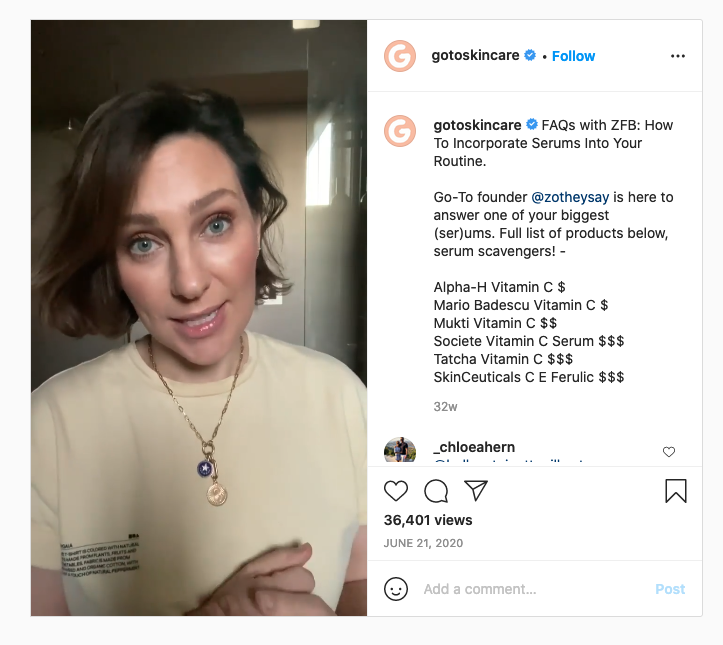Video is no longer just another tool in your digital marketing toolkit. Today, it’s a critical component in engaging your target audience online – especially on social media.
According to data from HubSpot, short-form video is the most-popular content type on social media for increasing audience engagement. Not only that, but 91% of businesses use video marketing as a tool.
The benefits of video are far-reaching, but without a big budget or a video marketing agency to lean on, knowing where to start can be tricky. Fortunately, though, even small businesses can reap the rewards of video marketing with a little planning. We’re here to help you do just that.

Why video marketing matters.
Before we get into the thick of things, let’s first look at why video marketing is a great investment for small businesses.
Watching videos online has become increasingly popular, audiences now dedicate an average of 17 hours a week to watching videos online. This trend underscores the necessity for brands to engage in video marketing to remain competitive. According to a study by Wyzowl, 87% of video marketers report that video has helped them generate leads.
The last few years have seen a major surge in video as a digital marketing tool. One of the biggest reasons for this is, quite simply, it’s effective, with 91% of marketers saying video marketing has given them a good return on investment (RO). (return on investment).
In other words, if you aren’t at least thinking about ways to incorporate video into your digital marketing strategy, you’re at risk of being overshadowed by competitors. Conversely, adding video to your content marketing mix sooner rather than later could spell a major step-change in customer acquisition – no matter what industry your business is in.
Video marketing encourages social shares and engagement.
Video marketing is a powerful tool for encouraging social shares and engagement. According to a study by Wordstream, social videos generate 1200% more shares than text and images combined. This staggering statistic underscores the potential of video content to amplify your brand’s reach on social media platforms.
When you create engaging video content, it naturally sparks conversations and inspires viewers to share their thoughts. This increased engagement not only boosts your brand’s visibility but also fosters a sense of community among your audience. By incorporating video into your marketing strategy, you can significantly increase social shares and engagement, driving more traffic to your website and ultimately boosting conversions.
Video marketing improves SEO and boosts conversions and sales.
Video marketing can significantly improve your website’s SEO by increasing the amount of time visitors spend on your site. When users engage with video content, it signals to search engines that your site offers valuable information, which can help boost your rankings. In fact, an article on Medium suggests that video content can boost organic traffic from search engine results pages (SERPs) by 157%.
By incorporating video into your marketing strategy, you can not only improve your website’s SEO but also increase conversions and drive more sales. Video content helps to reduce bounce rates and increase the average time spent on your website, further enhancing your SEO efforts. This makes video marketing a crucial component of any effective digital marketing strategy.
Establishing credibility and trust.
Video marketing is an excellent way to establish credibility and trust with your target audience. By showcasing your products or services in action, you can demonstrate your expertise and build confidence in your brand. According to Spiceworks, 48% of consumers feel more confident about online purchases after watching videos.
Video content also helps to humanise your brand, making it more relatable and trustworthy to your target audience. When potential customers see real people using your products or services, it creates a sense of authenticity and reliability. By incorporating video into your marketing strategy, you can establish credibility and trust with your target audience, driving more conversions and sales.
Popular types of marketing videos.
Almost every internet user will be familiar with at least some types of marketing videos. But it can be a challenge to figure out which types are right for your business. Here are some of the most common formats – and what they’re useful for – to help you get started.
Live videos.
Live videos – think Instagram Stories or Facebook Live – are a great opportunity to answer customers’ questions and give people a behind-the-scenes look at your business. This can include live-streaming events, interviews, conferences or anything that your audience might be interested in. Click on the image below to view an Instagram Story from Go-To Skincare.

Demo videos.
As the name suggests, demo videos showcase how your product or service works in a simple, easy-to-understand format. This could be taking viewers on a tour of your shop, running through a process or testing a product.
Explainer videos.
Explainer videos are intended to explain your business’ core product or service offering in a short, easy-to-digest format. You’ll often find explainer videos on a business’ website homepage or product/service page.
Tutorial/instructional videos.
How-to videos offer practical guidance to teach your audience something new or answer a question. Educational videos are also a great option, as they simplify complex information and enhance customer education. These videos are useful not only for showcasing your expertise but also helping attract new potential customers to your business.
Brand Story Videos.
One of the most impactful types of marketing videos is the brand story video. These videos effectively convey a company’s history, mission, and values, creating an emotional connection with the audience. By personalising the brand message, brand story videos foster customer loyalty and differentiate the brand in a competitive market.
Testimonial videos.
Potential customers want to know that your business is trustworthy – and one of the best ways to prove this is through customer testimonial videos. The most effective testimonial videos feature happy customers clearly describing the challenges they faced and how the business went above and beyond in solving them.
How to create your own marketing video.
As a small business owner, you probably don’t have the time to spend learning video editing software. And if you don’t have much experience in the video marketing realm, you might think your only option is to fork out thousands of dollars to pay for a video marketing company.
The good news is, even with limited resources, you can create engaging videos with just the smartphone in your pocket. Sure, they might not look quite as professional as, say, a traditional TV ad. But in the internet age, that’s absolutely fine.
RELATED: Blog and video content ideas for every industry.
Here are our best practice tips for creating great marketing videos on your own along with actionable video marketing strategies to help you achieve measurable results.
1. Have a goal.
Like any marketing tactic, there’s no point creating a video if you’re not clear on what you want it to do. Start by writing down one or two goals that will serve as guiding principles for your video marketing campaigns. This could be something like:
- Showcase my products or services
- Explain what my business does
- Grow awareness of my brand
- Demonstrate that my business is trustworthy
- Showcase my expertise in my industry

2. Choose your video format.
Once you’ve defined your goals, it’s time to figure out which type of video will best fit the bill. For example, if your goal is to ‘demonstrate that my business is trustworthy’, the best type of video might be a testimonial or a demo video of your team on the job. Don’t worry too much about getting the format ‘right’ – it’s more about knowing your audience and what they’ll be interested in. Which brings us to our next point …
3. Define your target audience.
Who will you be targeting with your video? Is it existing customers? People who know your business already but have never purchased from you? People who know nothing about your business? Consider your target audience’s shared traits, such as:
- Age, gender and geographic location
- Job roles and salary brackets, or budgets for B2B customers
- Buying behaviours
From there, ask yourself:
- What platforms does my audience use?
- What questions does my audience need answered?
- What does my audience want to know about my business?
- What problems does my audience need solved?
Answering these questions will help you figure out what sort of video content you should be creating and where you should post it.
For example, let’s say you own a hair salon with a clientele of mostly women aged 20-29. You’ve noticed that a lot of customers have recently been stopping in to buy a sea salt spray that helps create beachy waves. With this in mind, you could create an Instagram Story (the preferred platform for your customer demo) with a tutorial on how to create beachy waves at home.
This type of video is perfect for the demographic, but it wouldn’t perform very well if the customers were mostly men, or in an older age bracket. That’s why it’s so important to really know your target audience – and use it to guide your video marketing strategy.

4. Create a storyboard.
It might sound intimidating, but a storyboard is just a tool to help you plan your video from start to finish. It doesn’t have to be a series of complex sketches or a Shakespeare-level script. A good storyboard is as simple as:
Introduction: This could be introducing yourself, a customer or an interviewee, or setting the scene. The engagement rate drops to 80% after 5 – 10 seconds on an average marketing video, so your intro needs to be snappy.
Example: Hey ladies, Rachel here from Yuzu Salon.
Problem statement: What question will you be answering or problem will you be solving? Here’s where you make the purpose of the video clear.
Example: Today I’m answering one of my most asked questions: how to get relaxed beachy waves at home.
Solution/answer: This is where you get stuck into the details. In the case of a testimonial video, you can let the customer do the talking for you.
Example: It’s actually really easy! I’ll show you a quick step-by-step on how to do it yourself in just a few minutes…
Call to action: Perhaps the most important part of the video, this is where you let people know what you want them to do next (which should align with your goal for the video).
Example: So there you have it! Super easy. Check out my profile for more tutorials or DM me to book an appointment.

5. Get filming.
Now you’re ready to rock ‘n’ roll! Have your storyboard in mind while filming but don’t worry too much about following a script. You want to be as natural as possible and let your personality shine through. Remember, as long as it’s not a live video, you can do as many takes as you like until you feel comfortable.
Best practice tips for video filming.
- Choose a well-lit area. If you plan to film regularly, consider investing in a ring light
- Choose a location with minimal background noise
- Hold your camera vertically for Instagram Stories, or horizontally for video platforms like YouTube (for example, if you’re going to embed a video on your website)
- If possible, hold your film device on a steady surface to reduce shakiness.
Measuring video marketing success.
Measuring the success of your video marketing campaign is crucial to understanding its effectiveness. By tracking key metrics, you can refine your strategy and make data-driven decisions to improve your results. This process allows you to identify what’s working and what’s not, ensuring that your video marketing efforts are as effective as possible.
Track view count and engagement metrics.
View count is a key metric to track when measuring the success of your video marketing campaign. It provides a clear indication of how many people have watched your video. However, view count alone doesn’t tell the whole story. Engagement metrics, such as likes, comments, and shares, offer valuable insights into how your audience is interacting with your content.
By tracking these metrics, you can understand how your video content is performing and make adjustments to improve its effectiveness.
And that’s it! With these tips, you’ll be a marketing video producer in no time. When it comes to distributing your videos, our free social media template is a handy tool for planning your social content and staying on top of your schedule.
